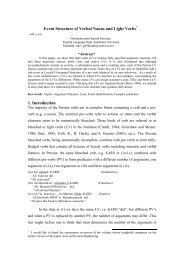Separability of Light Verb Constructions in Persian*
Separability of Light Verb Constructions in Persian*
Separability of Light Verb Constructions in Persian*
You also want an ePaper? Increase the reach of your titles
YUMPU automatically turns print PDFs into web optimized ePapers that Google loves.
arguments as <strong>in</strong> (15), when it functions as a heavy verb. However, it predicates different<br />
number and type <strong>of</strong> arguments as <strong>in</strong> (16) <strong>in</strong> its light use.<br />
(15) Ali keta:b-ra: be Sasan da:d. (Dative)<br />
Ali book-DOM to Sasan give-past<br />
‘Ali gave the book to Sasan.’<br />
(16) a. Ali ʔesteʔfa: da:d (Intransitive)<br />
Ali resignation give-past<br />
‘Ali resigned’<br />
b. Ali Sasan-ra: neja:t da:d (Transitive)<br />
Ali Sasan-DOM rescue give-past<br />
‘Ali rescued Sasan’<br />
c. Ali ʔota:q-ra: be Sasan ʔextesa:s da:d (Dative)<br />
Ali room-DOM to Sasan allocation give-past<br />
‘Ali allocated the room to Sasan.’<br />
In contrast to (15), <strong>in</strong> (16) the same LV predicates clauses with different number and type<br />
<strong>of</strong> arguments; depend<strong>in</strong>g on the predicational characteristics <strong>of</strong> the PV elements <strong>of</strong> the<br />
LVCs. Thus, it might be plausible to say that an LV has an unspecified, or defective astructure<br />
(Di Sciullo, 1990; Butt, 1995) which turns <strong>in</strong>to a fully-fledged one when the<br />
given LV co-occurs with another element, while a heavy verb bears a fully specified astructure.<br />
3.1.2. <strong>Light</strong> <strong>Verb</strong>s vs. Auxiliaries<br />
Persian auxiliaries (e.g. šodan ‘to become’, budan ‘to be’, da:štan ‘to have’,<br />
xa:stan ‘will’) <strong>in</strong> their usage as auxiliaries are different from LVs. LVs, bear<strong>in</strong>g lexical<br />
aspectual properties, contribute to the formation <strong>of</strong> predicates (= LVCs) by comb<strong>in</strong><strong>in</strong>g<br />
with PVs. In contrast, auxiliaries, only capable <strong>of</strong> carry<strong>in</strong>g functional features (e.g. tense<br />
and agreement), are unable to participate <strong>in</strong> LVC formation and they may only co-occur<br />
with already fully-fledged predicates either simple or complex. Consider the follow<strong>in</strong>g<br />
examples:<br />
(17) a. Ali na:me-ra: xa:had xa:nd. (Future)<br />
Ali letter-DOM will read<br />
‘Ali will read the letter.’<br />
11



